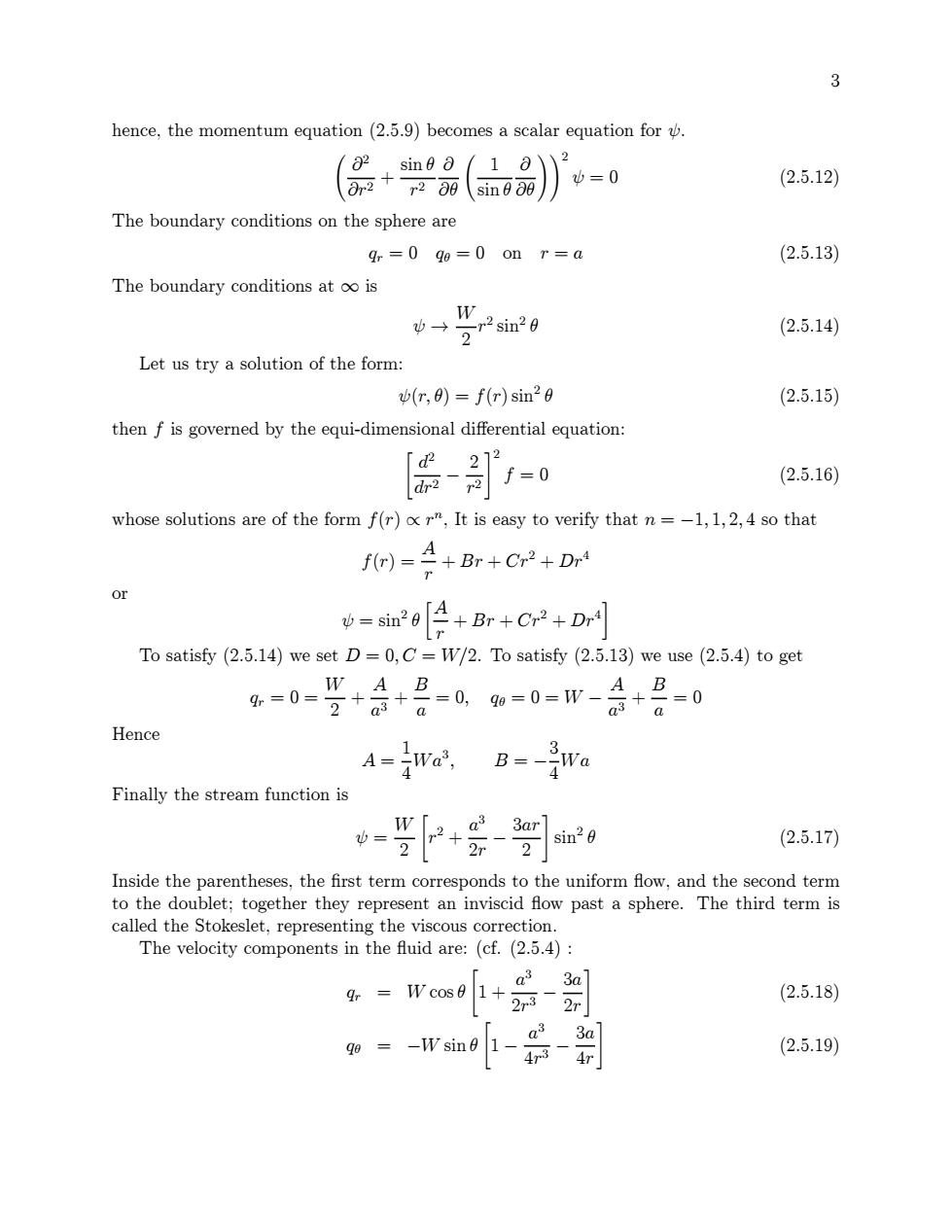正在加载图片...

3 hence,the momentum equation(2.5.9)becomes a scalar equation for 2 sin 1 2 ψ=0 (2.5.12) 8r2 r280 sin00 The boundary conditions on the sphere are gr=0 go=0 on r=a (2.5.13) The boundary conditions at oo is ψ→ 22n20 (2.5.14) Let us try a solution of the form: (r,)=f(r)sin20 (2.5.15) then f is governed by the equi-dimensional differential equation: d 272 dr2-2 f=0 (2.5.16) whose solutions are of the form f(r)o r",It is easy to verify that n=-1,1,2,4 so that )+Br+Cr+Dr or =m29[2+Br+c2+D To satisfy (2.5.14)we set D=0,C=W/2.To satisfy (2.5.13)we use (2.5.4)to get W A B 0三,+元女。=09如=0=w-A+B=0 a Hence A=-Wa, 1 Finally the stream function is W「 a3 3ar = sin20 2 2+2r 2 (2.5.17) Inside the parentheses,the first term corresponds to the uniform flow,and the second term to the doublet;together they represent an inviscid fow past a sphere.The third term is called the Stokeslet,representing the viscous correction. The velocity components in the fluid are:(cf.(2.5.4): Wcos 1+ 3a1 gr i 23-27 (2.5.18) ge =-Wsin0 a3 3a 1- 43 (2.5.19) 4r3 hence, the momentum equation (2.5.9) becomes a scalar equation for ψ. Ã ∂2 ∂r2 + sin θ r2 ∂ ∂θ Ã 1 sin θ ∂ ∂θ!!2 ψ = 0 (2.5.12) The boundary conditions on the sphere are qr = 0 qθ = 0 on r = a (2.5.13) The boundary conditions at ∞ is ψ → W 2 r2 sin2 θ (2.5.14) Let us try a solution of the form: ψ(r, θ) = f(r) sin2 θ (2.5.15) then f is governed by the equi-dimensional differential equation: " d2 dr2 − 2 r2 #2 f = 0 (2.5.16) whose solutions are of the form f(r) ∝ rn, It is easy to verify that n = −1, 1, 2, 4 so that f(r) = A r + Br + Cr2 + Dr4 or ψ = sin2 θ ∙A r + Br + Cr2 + Dr4 ¸ To satisfy (2.5.14) we set D = 0, C = W/2. To satisfy (2.5.13) we use (2.5.4) to get qr =0= W 2 + A a3 + B a = 0, qθ =0= W − A a3 + B a = 0 Hence A = 1 4 W a3 , B = −3 4 W a Finally the stream function is ψ = W 2 " r2 + a3 2r − 3ar 2 # sin2 θ (2.5.17) Inside the parentheses, the first term corresponds to the uniform flow, and the second term to the doublet; together they represent an inviscid flow past a sphere. The third term is called the Stokeslet, representing the viscous correction. The velocity components in the fluid are: (cf. (2.5.4) : qr = W cos θ " 1 + a3 2r3 − 3a 2r # (2.5.18) qθ = −W sin θ " 1 − a3 4r3 − 3a 4r # (2.5.19)